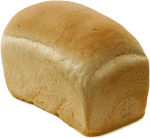April 14, 2005 at 10 PM
On Bread and Loaves Thereof
Moving to England has been a culinary adventure of sorts. Of course, it’s easy to poke fun of a national cuisine that treasures mushy peas, but English food isn’t really that bad.
(I will pause at this moment to point out that people often speak erroneously of “British food”. They only deep-fry Mars bars in Scotland, however, and I’ve yet to encounter an English recipe for haggis. And who even knows what they eat in Wales. Well, Welsh rarebit I guess.)
For one, the English have cheese. Up to their knees. Crumbly Lancashire, nutty Red Leicester, and, one I’ve been growing quite a fondness for, the delectable blue Stilton. (I could do without the fruity ones.) Of course, I’d be remiss in neglecting the most popular English cheese of all, which has pretty much conquered the English-speaking world. You probably didn’t even know (I didn’t) that Cheddar is an actual place in Somerset. English Cheddars at their best are delightfully sharp to taste, firm yet crumbly in texture, creamy in colour. I had a grilled cheese (a “toasted cheese sandwich” in these parts) today, and it was utterly fantastic.
Hurray for English cheese.
 Of course, one key ingredient for making a fantastic grilled cheese is good bread. This is where the English come up short. This is not a country of good bread. Like most places in North America, the vast, vast majority of loaves sold are the rectangular, colourfully-packaged, fluffy, tasteless white variety. Other staples in the British bread pantheon include “whole meal” (whole wheat to us North Americans), which has at least a smattering of taste, but still suffers from overall blandness in form and taste. Worse still are the “granary” loaves, and the various other blended breads which involve some ratios of whole and white wheat, occasionally another grain for good measure, and, to my eternal regret, malt.
Of course, one key ingredient for making a fantastic grilled cheese is good bread. This is where the English come up short. This is not a country of good bread. Like most places in North America, the vast, vast majority of loaves sold are the rectangular, colourfully-packaged, fluffy, tasteless white variety. Other staples in the British bread pantheon include “whole meal” (whole wheat to us North Americans), which has at least a smattering of taste, but still suffers from overall blandness in form and taste. Worse still are the “granary” loaves, and the various other blended breads which involve some ratios of whole and white wheat, occasionally another grain for good measure, and, to my eternal regret, malt.
If ever there was an ingredient that a thing like bread didn’t need, it was this. Malted bread flirts with you by having a pleasant brown tinge to its crust, and often provocatively promising extra seeds, but one taste and you’re in a nasty, sticky mess. It’s not worth the chew.
The only possible rationale I have come up with for this bastardization of bread is that it’s something they did in the War for rationing or something, and it just stuck around. It certainly explains a lot of other strange parts of the English diet, like Branston Pickle (a chunky, malted vinegar, vegetable spread, which looks and tastes as strange as it sounds, but is, admittedly, kind of appealing in that everyone-secretly-loves-Cheez-Whiz sort of way) or Lyle’s Golden Syrup (invert sugar syrup which is trying either to be like honey or maple syrup, but failing in every way to be as good as either. Bring me my Quebec sirop d’érable!).
Anyway, I’ve found a couple places in Nottingham that sell decent bread. (If you’re curious, Atlas, a coffee shop and deli in town makes some nice, fresh loaves, and some of the more hoity-toity ones at Sainsbury’s aren’t totally awful. Just watch out for that lurking malt.) I still miss rye bread though, and nothing approaching a halfway-decent sourdough or a crusty French loaf — forget baguettes, they’re all depressingly mushy — has yet crossed my path. If I feel one more loaf squish pathetically underneath my fingers, I swear will I will rush into the street yelling, “IT’S THE CRUST, STUPID!”
Needless to say, with all this wheat run amok, it was quite a, er, nose opener when a breadmaker arrived at my home recently. Out popped my first, fresh loaf of rye, and that was that. Sure, the crust was a little too thick, and my rye-to-white proportions weren’t quite right, but already it was better than 90% of the bread I’ve had here.
Why doesn’t everyone own a breadmaker? What a fantastic machine! I mean, you literally just dump the ingredients in, turn it on and a few hours later, out pops this miracle of toasty warm goodness. Toast for breakfast, eternally! Warm bread at supper! Assuming you’re not drunk while you’re measuring, it seems laughably difficult to screw it up. I can (nearly) forgive the Queen for her country’s cursed loaves. All is right as rain.
It’s also worth noting that my girlfriend, who has Celiac disease (that’s “Cœliac” for you Brits), and thus cannot eat wheat (or rye, for that matter), is currently experiencing an epiphany of sorts as she has discovered that wheat-free bread can actually taste good, especially when it’s sliced while still warm and moist. Yum.
Now I’m on the hunt for recipes. Why there’s a whole world of bread recipes out there, and the possibilities seem endless. Caraway seeds in rye! Sourdough with a thick, chewy crust! Onions, olives, sun-dried tomatoes or any of that other yuppy nonsense! Heck, the thing even claims to make jam. (Though really, the English make some really fantastic jams (Fortnum & Mason’s blackcurrant is really nice), so I’m not so concerned about that.
Anybody else have a breadmaker? Are you spreading the gospel? Why not? Why don’t more people know about this marvel of modern technology? I’d love to know some more good recipes for some tasty European breads.
Previously: Free the Testimony
Subsequently: Bugs in Safari 1.3





Comments
———
As another self-professed bread snob, I have to say I’m a little surprised, Luke. I mean, I know you don’t have a lot of choices, but I still find bread machine bread to be heavy, with a very weird crust that never comes close to ‘real’ bread. I imagine the convenience is almost worth it, and I’m intrigued by a machine that will make me pizza dough, but it still doesn’t satisfy my bread needs. The situation is so bad here in Utrecht, that I pay 5 (about $7 US) for a loaf of good bread from one of the only two good bakkerijs here: Crust and Crumbs, and the Bakkerswinkel.
— Emma | Apr. 16, 2005 — 8 AM
Well the key with the breadmaker is experimentation. If it’s too heavy, you can adjust the recipe. As for the crust, well, that’s still up for debate.
The thing is though, at least with this particular model, you can also choose to use it just to do the heavy lifting, and then you can shape the loaf yourself and bake it in the oven. I imagine that would give you flexibility enough to make something yummier.
— Luke | Apr. 16, 2005 — 10 AM